Zombieland Interview
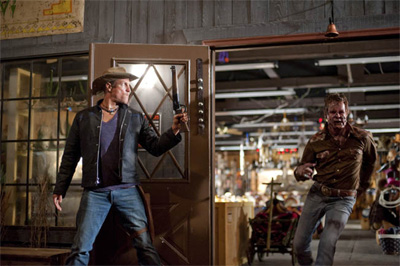
Zombieland
Cast: Jesse Eisenberg, Woody Harrelson, Emma Stone, Abigail Breslin, Amber Heard, Bill MurrayDirector: Ruben Fleishcer
Genre: Action, Adventure, Comedy, Horror
Rated: MA
Running Time: 88 minutes
Columbia Pictures' action comedy Zombieland focuses on two men who have found a way to survive a world overrun by zombies. Columbus (Jesse Eisenberg) is a big wuss - but when you're afraid of being eaten by zombies, fear can keep you alive. Tallahassee (Woody Harrelson) is an AK-totin', zombieslayin' badass whose single determination is to get the last Twinkie on earth. As they join forces with Wichita (Emma Stone) and Little Rock (Abigail Breslin), who have also found unique ways to survive the zombie mayhem, they will have to determine which is worse: relying on each other or succumbing to the zombies.
Woody Harrelson recently chose to be a part of the award-winning cast of No Country for Old Men, which won the Oscar® for Best Picture. And he follows up that choice with a movie called Zombieland? The actor says that he was impressed by the script. "Tonally, it rides the line between comedy and the impending danger of the zombies. It's tricky - you have to keep up a level of reality, or it becomes farce, but that presents its own challenges." Plus, the guy gets to kick zombie butt. What more could an actor ask for?
"I always saw Zombieland as Midnight Run with zombies," says Ruben Fleischer, director of the film. "Like that movie, it crosses so many genres at once. First and foremost, it's a comedy, a road movie. It's obviously got a horror element to it, and there's romance as well. I was excited because of all the different aspects of the film, and my goal was to keep it grounded and strike just the right tone."
Zombieland began with the original screenplay by Paul Wernick and Rhett Reese. "What attracted everybody to the project was the script," says Ruben Fleischer. "It's so strong. And Rhett Reese and Paul Wernick could not have been more collaborative while - and I respect them for this - staying true to their original vision."
"It reminds me a bit of what we used to do on 'Cheers,'" says Woody Harrelson. "If a joke doesn't work, they figure something else out - right there, while we're shooting, they'd come up with some new, funny line."
"We wore multiple hats out there," says Rhett Reese. "One is the producer's hat - we were looking at the overall picture and making sure that the movie was coming together the way we envisioned it."
"But there were various moments when lines had to change and we were writers again," says Paul Wernick, picking up the thread. "The sand shifts under your feet and you have to adjust. Seeing it all come together was a great experience - in a way, it was like film school for us."
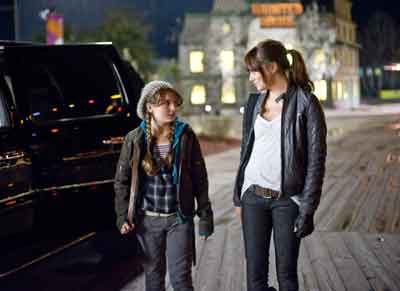 Woody Harrelson takes on the role of Tallahassee, a man who dies hard and slays harder, a dude ready to slay any zombie that comes between him and the planet's last remaining Twinkies. "When I read the script, the first actor who came to mind was Woody Harrelson," says Fleischer. "I saw elements in Tallahassee that reminded me of Woody Harrelson's character in Natural Born Killers, but with a humor laced through it."
Woody Harrelson takes on the role of Tallahassee, a man who dies hard and slays harder, a dude ready to slay any zombie that comes between him and the planet's last remaining Twinkies. "When I read the script, the first actor who came to mind was Woody Harrelson," says Fleischer. "I saw elements in Tallahassee that reminded me of Woody Harrelson's character in Natural Born Killers, but with a humor laced through it.""When I read the script, what I loved about Tallahassee was that he was a guy who essentially lost everything, so he has nothing left to lose, and as a result, he's fearless when it comes to his approach to the zombies," says Wood Harrelson. "After a great meeting with Ruben Fleischer, I was eager to be a part of it."
"We had all seen No Country for Old Men around the time we began the casting process," recalls Gavin Polone, "and Woody Harrelson just popped off of the screen. He was always our first choice."
"Tallahassee is childlike, impulsive," says screenwriter and executive producer Rhett Reese. "It made such sense to us that the Twinkie would be his greatest desire: it's a metaphor for the past, a piece of his former life, something he clings to - we all cling to things from our childhood, but he's clinging to something from the pre-apocalyptic days. Plus, it stays fresh on the shelf for a quite a while."
For the role of Columbus, Ruben Fleischer also had a specific actor in mind. "There are a lot of talented young actors who we considered, but Jesse Eisenberg was always at the top of my list," says the director. "I had loved him in Roger Dodger and in meeting with him, he displayed an innate humor and sensitivity. He's intrinsically funny, and his body language makes you believe he's the biggest coward in the world. He was Columbus."
"I loved the character when I read it," says Jesse Eisenberg. "I could certainly relate to Columbus' obsessive-compulsiveness; he's the type of guy who can't let himself enjoy anything. It was written very honestly, and I looked forward to being able to find the balance between that truth and the inherent humor in it."
"I loved the script, its sense of humor," adds Jesse Eisenberg. "When I met the writers, Rhett Reece told me that they based Columbus on him. And that was evident upon shaking his hand."
"It's kind of a bummer," admits screenwriter-executive producer Rhett Reese, "but yes, I'm Columbus. I've spent my life afraid of just about everything at one point or another. It was amusing to see Jesse Eisenberg run with that."
Joining Columbus and Tallahassee on their quest to survive are Wichita, played by Emma Stone, and Little Rock, played by Abigail Breslin. "There are very few beautiful, young actresses who have the comedic sensibility and the diversity to be able to show all the sides of the character that Emma Stone has created in this movie," says director Ruben Fleischer. "She's already proven her comedic prowess in films like Superbad and The House Bunny, but the character of Wichita is not necessarily a comedic role. She's a femme fatale, a classic hot, badass chick. What's amazing about Emma Stone is that she can portray all that and also has the comedy to back it all up."
"This script was very different than anything I had ever read," says Emma Stone. "There have been zombie comedies before, but this wasn't a satire in any way. The zombies are very scary, and they pose a very serious threat to the characters. They're not jokes by any means, but the four main characters are also very funny in their own right. The honesty and the humor made me feel that I could actually relate to how someone would feel and react in this zombie-ridden, postapocalyptic world. That was enough reason to want to be part of this film."
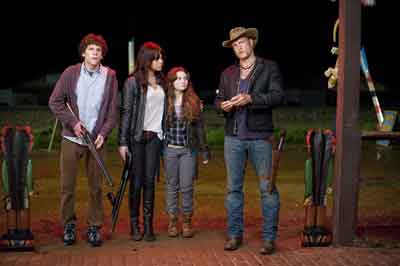 "I loved that this movie is funny, but not a rip-roaring slapstick, and it's scary, but not a terrifying nightmare-inducer. It manages to strike a balance between those and be its own thing. It's a multifaceted zombie movie. Who knew you could make that?"
"I loved that this movie is funny, but not a rip-roaring slapstick, and it's scary, but not a terrifying nightmare-inducer. It manages to strike a balance between those and be its own thing. It's a multifaceted zombie movie. Who knew you could make that?"For Little Rock, Wichita's partner, the director had a very specific idea. "When I read the script, I said, 'Abigail Breslin would be great for the part of Little Rock, but there's no way she'd ever do it, so we'll just have to find someone like her,'" says Ruben Fleischer. "And that's how it went for a really long time. Then, amazingly, she wanted to do the movie, and suddenly I had two Academy Award®- nominees in our zombie movie."
"I really wanted to do this movie, because it's different than anything I've ever done," explains the actress. "Little Rock is a very feisty character, and I've enjoyed doing all this action. I had to learn how to shoot guns, which I've never done, and when we shot in the amusement park, I got to go on a lot of the rides when we weren't filming. I had a lot of fun."
Abigail Breslin gave everything to the role that the director had hoped for. She more than acquitted herself among her co-stars who couldn't have been more appreciative of her talents. "Abigail Breslin is thirteen," says Woody Harrelson. "And I will never have acting chops like she has. She did one scene where she had to cry, and she did it in every single take. Sobbing. And even when she wasn't on camera, doing someone else's close-ups, she still gave it her all, and cried just as convincingly for the other actors. She is phenomenal, and really fun to hang out with."
"What was amazing to watch was the chemistry between Emma Stone and Abigail Breslin," says Paul Wernick.
"They slowly melded into one creature - Emmagail," adds Reese. "But what was really shocking was how the 13-year-old and the 20-year-old - the people you might think would be immature or naïve - were the wily veterans.
Helming the project is Ruben Fleischer, who makes his directorial debut. "I never had any anxiety whatsoever about Ruben Fleischer," says the producer, Gavin Polone. "I've worked with many first-time directors, and I was confident that Ruben had the vision and the commitment the project needed."
"Ruben Fleischer has a wonderful eye and a great sense for comedy," says Rhett Reese. "He's such a sweet, ego-free, inclusive person. When things go well, he's never the one to take the credit - he's quick to lavish praise on the people he works with."
Ruben Fleischer says that he was excited for the challenge of directing Zombieland - after all, "as a first time director, every scene was something I'd never done before. On my first day, we were killing zombies, and soon after, we were shooting in a giant mansion. Every day was a new experience. But the core is the same: you start with a script and you think about how you envision it, but it really comes to life when you get the actors, the production designer, the director of photography - they make it look spectacular."
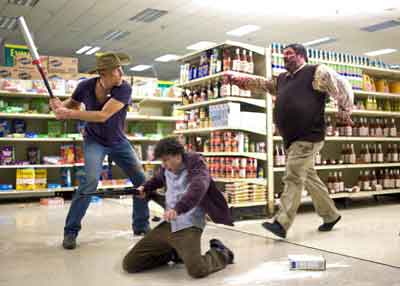 About the Production
About the ProductionVery early on in pre-production, Ruben Fleischer also began to shape the look of the film and the all-important zombies. "Before I started working on this film, the only zombie movie I had ever seen was 28 Days Later," admits the director. "At the time, I wasn't really a devotee of zombie films, but once I began approaching the job, I started researching like crazy, and familiarised myself with all the movies just to make sure I was doing justice to them. I have a great deal of respect for the audience of the genre, and I wanted to make sure they would be happy with the movies that we made."
In the writing of the script, it had been decided that there wouldn't be any explanation of what caused humanity to be overtaken by the zombie plague. "This is a post-apocalyptic world," says Ruben Fleischer. "It's not people in the midst of a zombie scourge. Our story is about the people we're following in this world, where there are way more zombies than people, and we wanted to tell the story of some of these few survivors struggling to make their way through."
With that vision in mind, production designer Maher Ahmad would begin to shape the physical world that the characters inhabited. "Ruben Fleischer and the writers determined that the story takes place just a couple of months after the major transformation of human into zombie, so our landscape is one more of abandonment than outright destruction. It's not about buildings falling down or vegetation growing over. It is one of the spookiness that comes with abandonment and the fear that comes from not knowing what is around any corner."
As for the look of the zombies themselves, one key decision was that the zombies would not themselves be funny; instead, they would be the straight man of sorts that the characters could play against. To achieve that, Ruben Fleischer decided to jettison some tired zombie lore in favor of a more modern take. "The classic and traditional zombies came from the undead," explains the director. "I wanted to ground this story in reality as much as possible, so we determined this was a real disease that evolved and spread as a viral-based situation."
Ruben Fleischer, special effects makeup designer Tony Gardner, and Tony Gardner's team researched infectious diseases, and their physical manifestations in the extreme stages. Explains SFX makeup artist Stephen Prouty, "What we wanted to show was that these people were infected. They're still alive, but they're ravaged with fever so they're always wet and dripping, they're hemorrhaging from all their orifices and spewing up a black bile-like substance."
Despite their condition, Ruben Fleischer also wanted his zombies to retain a sense of their individuality. "Rather than just have everyone dressed like businessmen, or in jeans and t-shirts, I tried to have some of the wardrobe reflect who they were before they came down with the plague. We have some dressed as fast-food workers, farmers, depending on their geographical location in the story. At one setting, the L.A. amusement park, we had a lot of fun with the zombie characters, but overall I wanted to make sure that you never lost the person in the zombie, that you could always sense who that person was before they got transformed."
That transformation affected hundreds of zombie extras, none more than the amusement park sequence. Over one hundred zombies (who had all auditioned in local casting calls) went through the makeup process. Their time in the makeup chair was dependent upon their action and placement in the scene. Stephen Prouty explains, "The more involved makeups, which included the prosthetic appliances, took close to an hour and a half. Then we had a mid-range level, which didn't involve prosthetics - about 30 minutes. This is more of a paint job and application-using a drippy, gooey substance, tooth stain and contact lenses. Those who were in the deep background got some wetness, blood, and some sputum coming out of their mouth. That was a fifteen minute job."
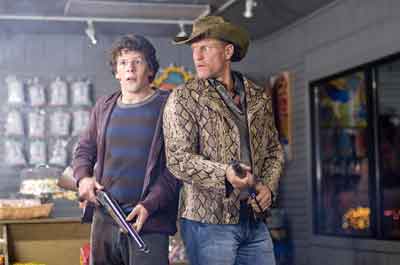 Production began in Georgia, where the filmmakers found their perfect theme park for the close of the film. "I'd shot two things in Georgia before and I had good experiences with those crews, even though they were on a much smaller scale," says Ruben Fleischer. "The great thing about not shooting in Los Angeles is the excitement that people have about being part of a movie. There's no way anyone in L.A. with a mansion like we have in the movie would ever let anyone film in it. Shooting there added so much production value."
Production began in Georgia, where the filmmakers found their perfect theme park for the close of the film. "I'd shot two things in Georgia before and I had good experiences with those crews, even though they were on a much smaller scale," says Ruben Fleischer. "The great thing about not shooting in Los Angeles is the excitement that people have about being part of a movie. There's no way anyone in L.A. with a mansion like we have in the movie would ever let anyone film in it. Shooting there added so much production value."Shooting began with the Pacific Playland sequence that serves as the climax of the film. In fact, it was Ruben Fleischer who first suggested the idea of the final battle in the park. "Once Ruben Fleischer made that suggestion, suddenly, that became the anchor for the film," says Rhett Reese. "It became a sandbox to play in, in terms of writing action, which is something Paul Wernick and I enjoy a lot."
Why an amusement park? "It's kind of a wish fulfillment thing," explains Ruben Fleischer. "This is a place that Little Rock loved as a younger child, and in a post-apocalyptic world, where you can do anything and go anywhere you want, Wichita just wants to help her sister relive a cherished childhood memory."
Once the filmmakers had settled on the location that would double for Pacific Playland, the screenwriters began tailoring the script to that park. "We walked through the park - Michael Bonvillain, our director of photography, Maher Ahmad, the production designer, and George Aguilar, our second-unit director and stunt coordinator. We'd find a cool ride and we'd think, 'Oh, wouldn't it be cool if Woody Harrelson or Jesse Eisenberg did this or that?'"
Though it might seem that shooting the end of the movie first would put the actors at a disadvantage, Woody Harrelson notes that it was just the opposite. "It helped me streamline my performance," he says. "Because we were shooting action, we weren't 'exploring the scene' - we'd have only a few seconds to react, in character, before the cut. So that helped me get in my characters mindset, and it also helped us gel as a team while we were there."
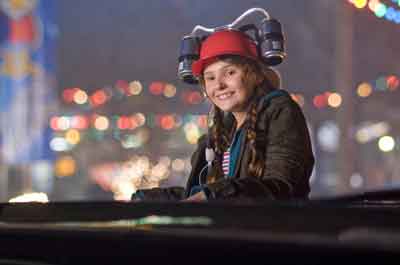 "The people at the park were incredibly collaborative - they really bent over backwards to make sure that we had whatever we needed," says Ruben Fleischer. "There were ride operators, ducked down and tucked behind every one of those rides in the movie, working with us through the nights to make sure we got our shots."
"The people at the park were incredibly collaborative - they really bent over backwards to make sure that we had whatever we needed," says Ruben Fleischer. "There were ride operators, ducked down and tucked behind every one of those rides in the movie, working with us through the nights to make sure we got our shots."Ruben Fleischer says working with his talented crew was a priceless experience for a first-time director. "I don't want to sound pretentious - I know this is a comedy - but these guys make the movie more cinematic than your average comedy. Every shot Michael Bonvillain did impressed me - he raises the bar. And Maher Ahmad's designs are incredible - he designed and built the grocery store from scratch, which is amazing, but what really blew my mind is the scene in which Columbus and Tallahassee first meet on the highway. We have 75 cars and 30 wrecks and a boat… the scale of destruction and devastation is serious production value. I considered myself so lucky to work with people like these."
On the final day of shooting, the crew was in Los Angeles, gathering in front of the iconic Grauman's Chinese Theatre in Hollywood, where the four survivors would encounter a west coast contingent of zombies.
Hollywood Boulevard was closed to traffic at 3:00 AM so that the art department could transform the normally mobbed tourist attraction into a scene of postapocalyptic devastation and abandonment. As the morning progressed, crowds gathered to watch the actors face off against the menace, and speed away in a yellow Humvee. Not at all a bad way to wrap.
MORE
- Emma Stone Magic in the Moonlight
- Jessica De Gouw Cut Snake
- Maxine Peake Funny Cow
- Denzel The Equalizer 2
- Johnny Flynn Beast
- Logan Marshall Green Upgrade
- Shailene Woodley Adrift
- Eric Toledano and Olivier Nakache C'est La Vie...
- André Leon Talley The Gospel According To André...
- Shakespeare In Tokyo
- Mission: Impossible Fallout
- Glenn Close The Wife
- Allison Chhorn Stanley's Mouth Interview
- Benicio Del Toro Sicario: Day of the Soldado
- Dame Judi Dench Tea With The Dames
- Sandra Bullock Ocean's 8
- Chris Pratt Jurassic World: Fallen Kingdom
- Claudia Sangiorgi Dalimore and Michelle Grace...
- Rachel McAdams Disobedience Interview
- Sebastián Lelio and Alessandro Nivola...
- Perri Cummings Trench Interview



